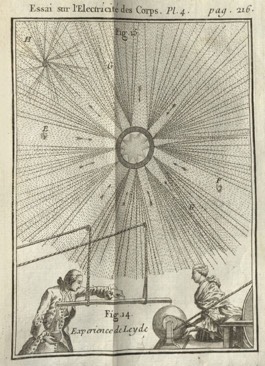Sign up for FlowVella
Sign up with FacebookAlready have an account? Sign in now
By registering you are agreeing to our
Terms of Service
Loading Flow



BACK
EXPLORE
LEARN MORE
In 1746, Pieter van Musschenbroek, a Dutch scientist at Leiden University, conducted “a new but terrible experiment.” By electrifying a glass jar filled with water, he managed to store electricity within the vessel, while his hand reaching towards the conducting wire received a most violent shock. The vessel was to become known as the Leyden Jar, the precedent of modern capacitor or battery. Here in Jean Antoine Nollet’s representation of the experiment, the dangerous incident is transformed into a light-hearted salon collaboration between the sexes, and conceptualized by the radiant diagram above them.
Anonymous
The Leiden Experiment on Electricity
Plate 4 (page 216) from M. l’Abbé Nollet, Essai sur l’électricité du corps, 1753
Engraving
Sarah Campbell Blaffer Foundation
2015.3

1

2

3

4

5

6

7

8

9

10

11

12

13

14

15

16

17

18

19

20

21

22

23

24

25

26

27

28

29

30

31

32

33

34

35

36

37

38

39

40

41

42

43

44

45

46

47

48

49

50

51

52

53

54

55

56

57

58

59

60

61

62

63

64

65

66

67

68

69

70

71

72

73

74

75

76

77

78

79

80

81

82

83

84

85

86

87

88

89

90

91

92

93

94

95

96

97

98

99

100

101

102

103

104

105

106

107

108

109

110

111

112

113

114

115

116